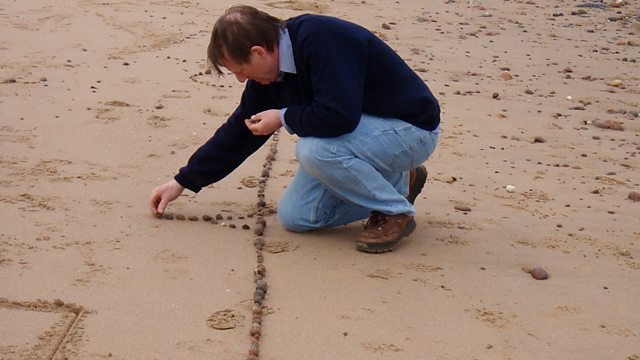Lines
The life of lines: on a page, on canvas, in nature and in life. With William Kentridge, Imtiaz Dharker and Timothy Ingold.
Our world seems to be bound and criss-crossed by lines: except that when you look closely, many of them do not exist in reality, only in your mind. So what are we to make of lines: a useful human abstraction, to help us make sense of the world? And what does a line mean to an artist, whether one who wields a paintbrush or pencil, or one who fashions words into poetic verse? Joining Bridget Kendall are distinguished South African artist William Kentridge, poet and graphic artist Imtiaz Dharker and social anthropology professor Timothy Ingold.
(Photo: Lines of pebbles on the beach with Timothy Ingold)
Last on
Clip
-
![]()
Imtiaz Dharker: lines of poetry as footprints on snow
Duration: 01:13
Chapters
-
Timothy Ingold
The Life of Lines
Duration: 11:20
William Kentridge
Thinking in lines
Duration: 07:57
60 Second Idea
A revolution in writing
Duration: 07:26
Imtiaz Dharker
Pen strokes on paper
Duration: 09:38
Timothy Ingold
![Timothy Ingold]() Professor Timothy Ingold holds the Chair of Social Anthropology at the University of Aberdeen. One of his recurring research themes is the idea of lines and human life: starting from the premise that what walking, observing and writing all have in common is that they proceed along lines of one kind and another, one of his projects was to forge a new approach to understanding the relation, in human social life and experience, between movement, knowledge and description. He is the author of Lines: A Brief History and The Life of Lines (forthcoming)
Professor Timothy Ingold holds the Chair of Social Anthropology at the University of Aberdeen. One of his recurring research themes is the idea of lines and human life: starting from the premise that what walking, observing and writing all have in common is that they proceed along lines of one kind and another, one of his projects was to forge a new approach to understanding the relation, in human social life and experience, between movement, knowledge and description. He is the author of Lines: A Brief History and The Life of Lines (forthcoming)William Kentridge
![William Kentridge]()
Over the last three decades, the visual artist William Kentridge has garnered international acclaim for his work across media including drawing, film, sculpture, printmaking and theatre. Rendered in stark contrasts of black and white, his images reflect his native South Africa and, like endlessly suggestive shadows, point to something more elemental as well. Kentridge is the recipient of numerous prizes and honorary doctorates, and his work has been exhibited widely throughout the world, including at the Tate Modern, the Louvre, Centres Pompidou, the Hirshhorn Museum and Sculpture Garden, and the Palais des Beaux-Arts in Brussels. His lifelong focus on line and drawing is summed up in his recent book, Six Drawing Lessons, based on the prestigious Charles Eliot Norton Lectures.
Imtiaz Dharker
![Imtiaz Dharker]()
Imtiaz Dharker is a poet, artist and documentary film-maker. Her collections of poems include Purdah, Postcards from god, I speak for the devil, The terrorist at my table, Leaving Fingerprints and Over the Moon. Recipient of the Cholmondeley Award and a Fellow of the Royal Society of Literature, her poems are on the British GCSE and A Level English syllabus. She has had a dozen solo exhibitions of drawings in India, London, New York and Hong Kong. She scripts and directs films, many of them for non-government organisations in India, working in the area of shelter, education and health for women and children.
60 Second Idea
![60 Second Idea]()
Timothy Ingold wants to invent a form of writing which would render all keyboards and screens obsolete. Its graphic elements would be shaped by expressive movements of the body, especially arms, hands and fingers. It would use a simple hand-tool, causing a dark liquid to flow by gravitational and capillary force into a light but absorbent surface. This new writing system would have a hugely expressive range, communicating not just by choice of words or emoticons, but by subtle nuances of line and texture. And it would involve no consumption of electrical energy.
Broadcasts
- Mon 17 Nov 2014 03:05GMT成人快手 World Service Online
- Tue 18 Nov 2014 09:05GMT成人快手 World Service Online
What is the role of libraries in the digital age?
Podcast
-
![]()
The Forum
The programme that explains the present by exploring the past








